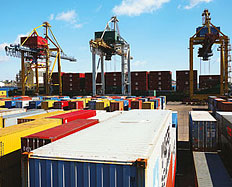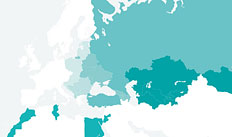COUNTRY ASSESSMENTS
Jordan
HIGHLIGHTS OF THE PAST YEAR
- Jordan’s economy proved vulnerable to external commodity price shocks as well as a worsening of its fiscal situation. Both problems were likely to be amplified by regional political turmoil. The IMF has approved a request for a US$ 2 billion Stand-By Arrangement in August 2012.
- Important progress has been made in financial sector reform. Jordan has advanced in harmonising Basel III standards in capital, leverage and liquidity standards to strengthen banking supervision and risk management.
- Legislation to improve the overall business environment is advancing. A new Secured Lending Law has already been passed and a number of new draft laws have been developed on investment policy, bankruptcy and insolvency and an Islamic Sukkuk law.
KEY PRIORITIES FOR 2013
- Reform of the municipal infrastructure sector is urgently needed. Significant resources are required to address water scarcity and enhance the efficiency of water usage and distribution. Private capital would help to fund upgrades of the urban transport systems through transparent public-private partnerships (PPPs).
- Further efforts to improve energy efficiency need to be made. A combination of a very energy intensive industrial sector coupled with persistent energy supply disruptions to the main gas pipeline from Egypt have resulted in an expensive overall energy bill. Reforms to increase the share of renewable energy are still outstanding and steps need to be taken to diversify sources of energy in the long term.
- A key priority is addressing water scarcity and implementing reforms in the water and wastewater sectors, in order to increase private sector participation, as well as to reform tariffs to reflect water scarcity. Improvements in water regulation and operational performance are also needed to meet increasing water demand.
MACROECONOMIC PERFORMANCE
The Jordanian economy continued to grow only moderately during the first half of 2012. Real GDP growth reached 3 per cent in the first quarter of 2012, and slowed slightly to 2.9 per cent in the second quarter, supported by a rebound in tourism and strong performance of the financial services sector, a key driver of economic growth. However, growth in the first half of the year was dragged down by a slow-down in manufacturing activity, along with contractions in agriculture, mining and construction. Policy space has been substantially reduced this year limiting the government's ability to boost economic growth. Inflation has risen throughout the year, reaching 4.8 per cent in August, up from 3.3 per cent in December, mostly due to increases in food prices, transportation and communication costs.
Fiscal and balance of payments pressures have intensified this year, prompting Jordan to seek and receive IMF assistance. The three-year, US$ 2 billion (7 per cent of GDP) Stand-By Arrangement approved by the IMF should help Jordan correct fiscal and external imbalances while maintaining the exchange rate peg. After reaching 12 per cent of GDP in 2011, the current account deficit has widened during 2012. Exports fell in the first half of 2012, but tourism and remittance flows have held up. FDI, however, remained depressed due to regional turmoil. The authorities have begun to implement a fiscal reform programme (a condition of the IMF loan) which will see increases in revenue‑generating measures, such as tax increases on cars, tobacco, alcohol and airfares, along with cuts to subsidies and capital investments. The country remains dependent on foreign grants and loans, from bilateral sources (France, Japan, US and GCC) and IFIs, to secure its financing needs. Jordan also secured a US$ 250 million loan from the World Bank for budget support. In addition, the European Union has agreed to a €3 billion support package, to be disbursed over the next three years.
Risks to the economic outlook are significant. Growth will remain sluggish in 2012 and, with the conflict in neighbouring Syria likely to stay protracted, the negative repercussions on tourism and on investors’ perceptions of the region are likely to be felt. Remittances are likely to remain strong especially since Gulf Cooperation Council economies are expected to perform well in 2012-13, but increasing energy prices and possibly unstable gas supply from Egypt could pose further problems.
MAJOR STRUCTURAL REFORM DEVELOPMENTS
Economic reforms progressed cautiously throughout the year, with several important laws introduced since the beginning of 2011. These fall under the purview of the country’s action plan, which is based on the Executive Development Programme of 2011-13. The programme is not only very comprehensive, addressing both regulatory and investment bottlenecks, but also demonstrates a clear focus on private sector involvement and support from the international community. Reforms in some key areas have already been undertaken, but they are lagging behind in others.
Jordan has made substantial progress in financial sector reforms. The appropriate regulatory framework and supervision mechanisms have been adopted through the completion of Basel II implementation in 2009, and the implementation of Basel III is ongoing in 2012. An automated data collection system was introduced in June 2010 and cross-border bank regulation has been enhanced. In 2010 the law establishing Private Credit Bureaux was adopted, but the first bureau is yet to be established. The low effectiveness of enforcement of bankruptcy procedures among borrowers, however, remains a significant impediment to increasing lending to both consumers and corporate borrowers.
While the government recognises the large challenges of the energy sector as one of its main priorities, it has only made limited progress so far on the reform side. The industrial sector remains very energy intensive, and significant reforms have not yet been enacted to increase the share of renewable energy in total generation. On the other hand, energy subsidies have expanded substantially in 2011. However, increasing fiscal pressures, associated partly with the rise of gas prices due to persistent disruptions to the pipeline from Egypt, have forced the government to modify some of those subsidies. As a result, subsidies on premium fuels were decreased in May 2012, while electricity tariffs for major industrial firms were raised.
Some reforms have been enacted to enhance competitiveness, investment, and private sector development along with labour market reforms. The legislative frameworks for both foreign and local investments have been improved. A new Secured Lending Law is now in place, in addition to a new draft Investment Law. Other laws that are in the pipeline for 2012 include a new Insolvency and Bankruptcy Law and an Islamic Sukkuk Law. Some structural issues with the labour market have been addressed, through a law easing the hiring and firing of workers. The government has also launched a US$ 211 million fund, running in partnership with the private sector and civil society, to promote inclusive growth and job creation. A US$ 1.41 million loan guarantee fund for SMEs was launched in August 2012 to facilitate SME access to credit.
Reforms are being enacted to ease conditions for local and foreign direct investment, especially in large infrastructure projects and in the municipal sector. Jordan has established public-private partnership-specific central government institutions and is in the process of enacting a PPP law (as opposed to the existing Privatisation Law, which is broader in focus). The government is also planning to launch a number of large infrastructure and renewable energy projects, which will require some sort of PPP formulation to attract the private sector.
Despite considerable structural reform, the sustainable energy sector still faces substantial challenges. Jordan has made considerable progress in unbundling and corporatising its power sector, including drawing in substantial private sector involvement. However, the regulated tariff system, which is not cost-reflective, along with persistent energy subsidies, has limited competition in the sector and is in need of reform. On the renewable energy side (which accounts for less than one per cent of production despite Jordan’s massive solar energy potential), the government published a framework in May 2012 to support and promote investment in the sector. However, due to limited fiscal space and constrained lending conditions in the banking sector, financing renewable energy projects remains a challenge. In this regard, a renewable Jordan Energy and Energy Efficiency Fund (JREEF) is in the process of being set up with the aim of providing some support for renewables and energy efficiency projects.







